Stock Market Crash: Definition, History, Causes, and Worst Stock Market Crashes
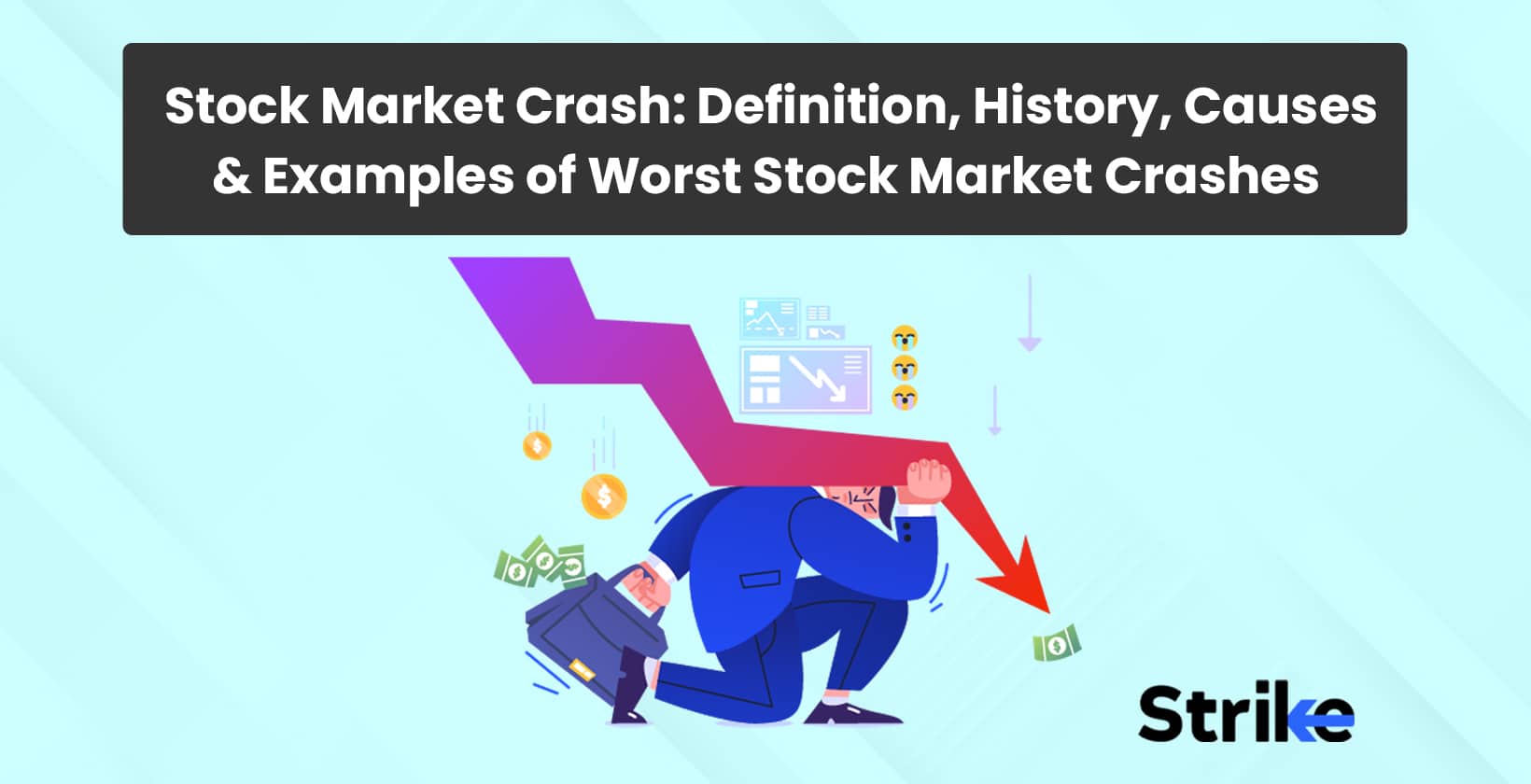
A stock market crash refers to an abrupt and significant drop in the value of the stocks that are traded on a stock exchange. A stock market crash is caused by the volatile and unpredictable nature of financial markets, which in turn causes catastrophic events. The Wall Street Crash of 1929, Black Monday in 1987, the Dot-Com Bubble Burst in 2000, and the Financial Crisis of 2008 are just some of the most notable stock market crashes in history.
A crash in the stock market is often attributed to economic downturns, speculative bubbles, panic selling, black swan events, and political instability.
Crashing stock markets are a normal occurrence that happens as a part of the economic cycle. These crashes present investors with an opportunity to purchase stocks at lower prices. Continue reading to find out more about it.
What does Stock Market Crash mean?
A stock market crash refers to an abrupt and unforeseen drop of stock prices, which leads to a significant decline in the overall market index. Stock market crashes typically take place after an extended period of rising stock prices and excessive optimism regarding the economy. Crashing of the stock market is frequently accompanied by widespread panic, which leads to investors quickly selling off their shares, which only serves to exacerbate the decline in prices.
A more comprehensive definition of a crash in the stock market takes into account not only the precipitous decline in stock prices but also the psychological toll it takes on investors and the subsequent ripple effects it has on the economy. These kinds of occurrences lead to significant financial losses, the failure of businesses, and even economic contractions that last for an extended period of time.
There are certain factors that can lead to a crash in the stock market, including the following.
Economic bubbles: An overvaluation of stocks lead to a speculative bubble, which will eventually burst when investors realize the prices are not sustainable, leading to a rapid sell-off.
Indicators of the economy: Poor economic data or forecasts are sometimes the cause of a crash in the market if investors believe the market is overvalued and adjust their investments accordingly.
Events on the political front: Unanticipated political events or crises have the potential to create uncertainty in the market, which may prompt investors to liquidate their stock holdings.
Investor sentiment: The mentality of following the herd is an aspect of market psychology that contributes to crashes in the stock market. A significant number of investors begin selling their holdings in a company’s shares has the potential to prompt additional investors to do the same, which can result in a spiralling decline.
Crashing stock markets have the potential to have a significant negative effect on the economy. They have the potential to bring about a decline in consumer spending, sluggishness in overall economic growth, and an increase in the rate of unemployment. Crashes bring about a decline in the value of businesses or even cause them to fail entirely, which further exacerbates the economic downturn.
What is the History of Stock Market Crashes?
The following is a brief overview of 12 of the worst crashes that occurred prior to the 19th century on the stock market.
The Tulip Mania (1637)
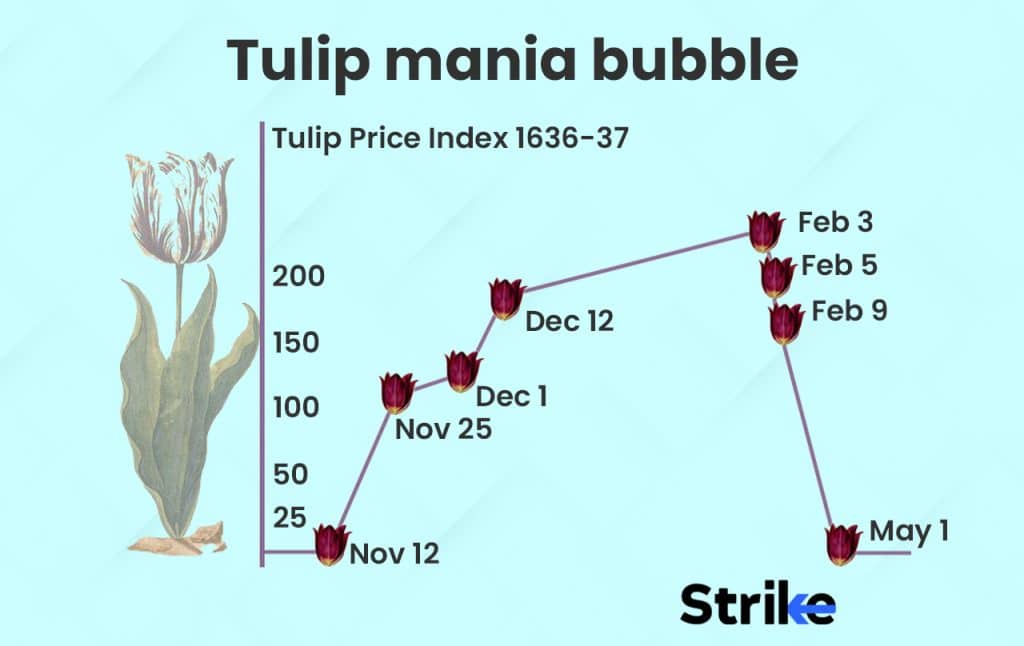
The speculative bubble in the prices of tulip bulbs in the Dutch Republic was the root cause. The crash caused the complete loss of wealth for a great number of investors and had a profound and long-lasting effect on the economy of the Netherlands. Additionally, it illustrates a speculative bubble at an early stage in its development.
The South Sea Bubble, 1720
The reckless growth and overvaluation of the South Sea Company, which at the time held a monopoly on trade with South America, was the root cause.
The crash had a devastating effect on the economy of the United Kingdom and caused a significant reduction in the country’s wealth. A great number of prominent families and individuals were brought to financial ruin, which resulted in a loss of public confidence in the economic system.
The Mississippi Bubble, 1720
The mania of speculation that surrounded the Mississippi Company, a French trading company that held monopoly rights in the Louisiana territory, was the root cause. The market collapse was responsible for a severe economic downturn in France and ruined the country’s reputation for having a sound financial system. The subsequent economic turmoil caused by the crash was a contributing factor in the demise of the Bourbon monarchy in the end.
The Crisis of 1772
A prominent English banking house called Neal, James, Fordyce, and Down went bankrupt, which resulted in a credit crisis in England. The crisis had the following effects: The crisis caused a significant decline in economic activity and a widespread loss of confidence in the financial system of the United Kingdom. The crisis resulted in the failure of a great number of businesses, and it contributed to the economic instability that helped fuel the American Revolution.
Panic of 1819
The United States experienced its first significant financial crisis in 1819, which was known as the “Panic.” It was brought on by a decrease in the demand for American goods across the globe, the conclusion of the Napoleonic Wars, and the revival of European economies. The financial crisis resulted in the failure of numerous banks, an explosion in the number of people looking for work, and a severe depression that lasted until the early 1820s.
Panic of 1837
The United States experienced yet another significant financial crisis in 1837, which was known as the “Panic of 1837.” This crisis was brought on by a number of factors, including speculative lending, land speculation, and the failure of multiple banks. The crisis resulted in a depression that lasted for seven years, during which time tens of thousands of businesses went bankrupt and unemployment rates skyrocketed.
Panic of 1857
The failure of the Ohio Life Insurance and Trust Company was the immediate cause of the Panic of 1857, which was a financial crisis that spread around the world and had its roots in the United States. The financial crisis spread to Europe, resulting in the failure of European banks, the shutting down of European businesses, and widespread unemployment. The Panic of 1857 brought to light flaws in the global monetary system, which would later be a contributing factor in the Panic of 1873.
Panic of 1907
The United States experienced a severe economic downturn as a result of the “Panic of 1907,” also referred to as the “Knickerbocker Crisis.” The failure of a significant New York bank known as the Knickerbocker Trust Company sparked the beginning of the panic. This resulted in widespread fear and the failure of several other banks, which in turn led to a crash in the stock market and a crisis in the availability of liquidity.
Wall Street Crash of 1929
The stock market crash that occurred on Wall Street in 1929, which was also known as Black Tuesday, was the most devastating crash in the history of the United States and marked the beginning of the Great Depression. The crash was caused by a speculative bubble that was fed by excessive borrowing, margin trading, and overpriced stocks. This bubble led to the crash. The crash of the market was the immediate cause of a severe and protracted slump in economic activity that didn’t end until the late 1930s.
Black Monday, 1987
The term “Black Monday” is used to describe the day of the stock market crash that took place on October 19, 1987. This was the day that stock market indices all over the world experienced a sharp and sudden drop in value. Several things, including computerized trading, an overvaluation of stocks, and investor panic, have been pointed to as the causes of the crash. The crash was severe, but it did not cause a sustained slowdown in economic activity after it occurred.
Dot-com Bubble Burst, 2000
The rapid expansion of internet-based businesses was a primary factor that contributed to the speculative bubble known as the dot-com bubble, which occurred in the late 1990s and early 2000s. In March of 2000, the bubble burst when the NASDAQ Composite Index, which had a significant weighting in technology stocks, reached its highest point and then began a rapid decline from that point onward.
A significant number of internet companies went bankrupt, and the stock market as a whole experienced a temporary decline as a result of the bursting of the dot-com bubble.
Financial Crisis of 2007-2008
The severe global financial crisis that occurred between 2007 and 2008, also referred to as the Great Recession, was a severe event that rocked the foundations of the economy all over the world. The financial crisis was brought on by a confluence of events, the most notable of which was the implosion of the housing market in the United States, the excessive risk-taking of financial institutions, and the failure of major banks.
The crisis led to a recession all over the world, the loss of a significant number of jobs, and significant intervention from the government in an effort to stabilize the financial system.
These stock market crashes serve as important lessons for investors, regulators, and policymakers, highlighting the risks associated with speculative bubbles, excessive risk-taking, and the interconnectedness of global financial markets. By studying these historical events, we can better understand the potential causes and consequences of future crashes and work to prevent them.
These early examples illustrate both the possibility of speculative bubbles and the potentially catastrophic effects on economic activity that can follow the bursting of such bubbles. We gain a deeper comprehension of the complex interplay of forces that underlie economic crises and make progress towards a more secure and robust economic future by investigating the factors that led to and repercussions of these market collapses.
What are the 3 factors that cause the Stock Market to Crash?
Speculation, panic selling and the bubble burst and the three main causes of a stock market crash. Below are more details about these.
1. Speculation
Speculation is when investors buy stocks based on the expectation that they will increase in value, rather than on their actual worth. This creates a speculative bubble that can temporarily drive up prices but is not sustainable in the long term.
An example of speculation is the dot-com bubble of the late 1990s and early 2000s, where investors poured money into internet-based companies with the expectation that they would continue to grow exponentially. Many of these companies went bankrupt and the stock market experienced a temporary decline when the bubble burst.
2. Panic Selling
Panic selling occurs when investors suddenly sell large amounts of stocks due to fear or uncertainty. This can cause a chain reaction of further selling, leading to a rapid drop in stock prices.
An example of panic selling is the “Black Monday” crash of 1987, where widespread investor panic led to a sudden drop in the value of stock market indices worldwide.
3. Bubble Burst
A bubble burst is when a speculative bubble inevitably bursts, causing stock prices to plummet as investors rush to sell their overpriced stocks. This can lead to a significant slowdown in economic activity and even a recession.
An example of a bubble burst is the Wall Street Crash of 1929, where a speculative bubble in the stock market led to a crash that marked the beginning of the Great Depression.
Investors and regulators can work to mitigate the risks associated with stock market crashes and strive towards a more stable and prosperous economic future by understanding these three factors and their potential consequences.
What are the Worst Stock Market Crashes in the 19th and 20th centuries?
The 1929 stock market crash, black Monday crash, the dot-com bubble, the 2008 financial crisis etc are the main stock market crashes in the last two centuries.
1. 1929 stock market crash
The Wall Street Crash of 1929, also known as the Great Crash or Black Tuesday, was the most devastating stock market crash in the history of the United States, marking the beginning of the Great Depression. The 1920s saw rapid industrialization, leading to a surplus of goods that could not be absorbed by consumer demand, and wealth was concentrated in the hands of a few, limiting the purchasing power of the majority, among other issues. These factors all contributed to the eventual stock market crash.
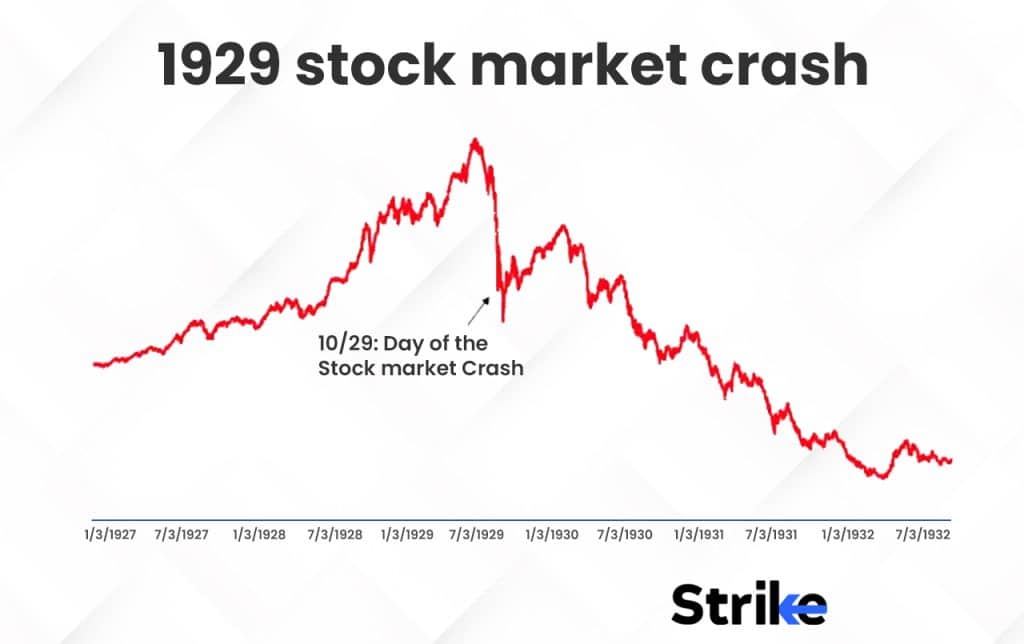
Key events leading up to the crash included the Florida land boom, a speculative real estate bubble in Florida that collapsed in 1926, and the Federal Reserve’s actions, which inadvertently contributed to the crash by raising interest rates in 1928 . The stock market began a rapid decline on October 24, 1929, known as Black Thursday, and ultimately lost 89% of its value over the next several years. The resulting economic downturn and widespread job losses lasted for over a decade.
2. Black Monday crash of 1987
Black Monday, which occurred on October 19, 1987, refers to the global stock market crash that resulted in the largest one-day percentage decline in stock market history. The Dow Jones Industrial Average (DJIA) dropped by 22.6%, leading to significant financial losses and widespread panic in markets around the world.
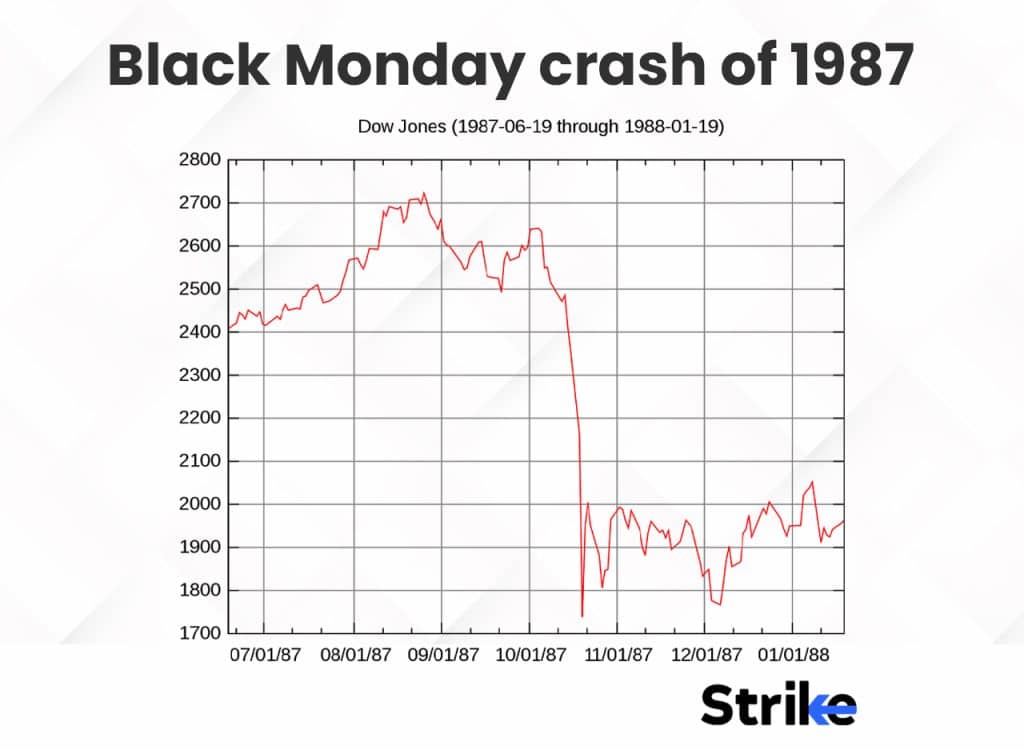
One of the causes of Black Monday was overvaluation. The stock market experienced a period of rapid growth, which resulted in the overvaluation of stocks. The DJIA rose by more than 40% in the months leading up to Black Monday, fostering an environment of speculative trading and inflated stock prices that ultimately contributed to the crash.
Another factor contributing to the crash was the rise of computerized trading systems, known as program trading. These systems were designed to automatically execute large-scale trades when certain market conditions were met. These systems exacerbated the market decline by executing a large number of sell orders simultaneously on Black Monday.
International trade imbalances were also a contributing factor to the crash. The U.S. trade deficit and the weakening U.S. Dollar contributed to global economic instability, and investors were concerned about the potential impact of these imbalances on the stock market, leading to a decline in market confidence.
The rising interest rates also played a role in the crash. The U.S. Federal Reserve had been raising interest rates in an attempt to combat inflation, which made borrowing more expensive and reduced the attractiveness of stocks as an investment, contributing to the decline in stock prices.
The impact and aftermath of Black Monday included significant financial losses for investors worldwide. The market lost approximately $1 trillion in value within a matter of days. Black Monday also led to several changes in financial market regulations, including the implementation of “circuit breakers” designed to halt trading temporarily in the event of significant market declines, as well as increased oversight of computerized trading systems.
The crash also contributed to an economic slowdown in the United States and other countries, with growth rates being negatively affected for several years following the event. Black Monday served as a valuable reminder of the inherent risks associated with investing in the stock market, leading to increased emphasis on risk management and portfolio diversification strategies.
3. Dot-com bubble of 1999-2000
The Dot-com bubble, also known as the Internet bubble or the tech bubble, occurred between 1999 and 2000. The bubble was a period of speculation where the stock prices of many internet-based and technology companies soared to unprecedented levels, before crashing and causing significant financial losses for many investors.
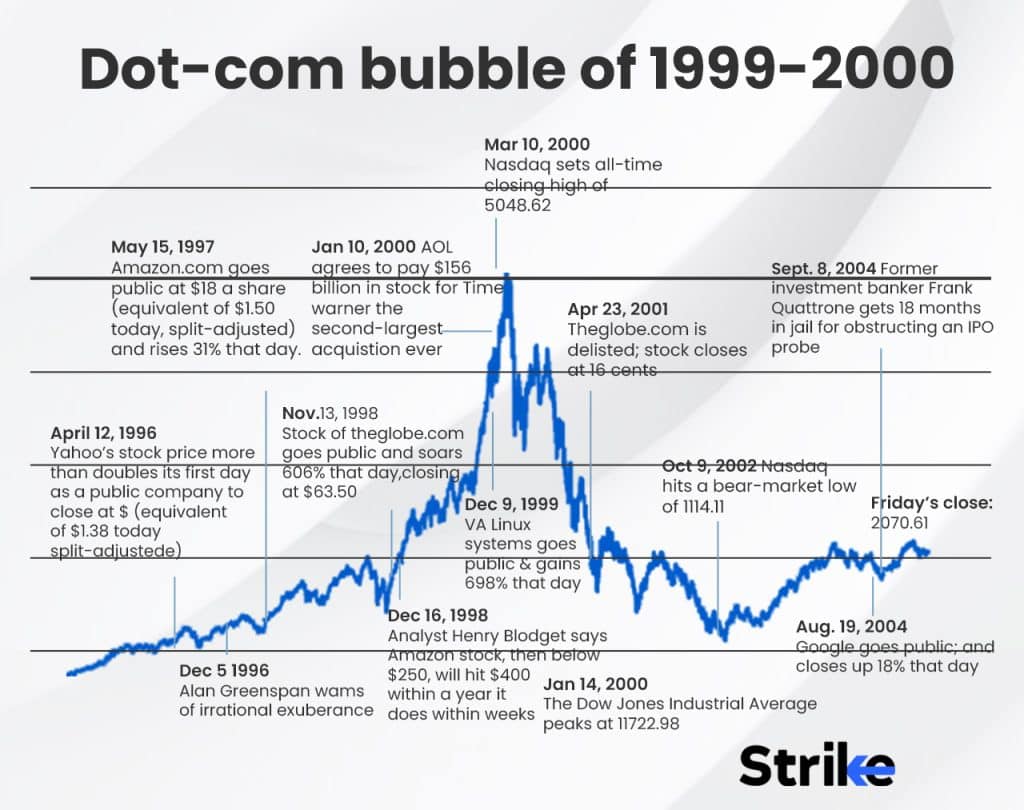
The widespread adoption of the internet in the 1990s fueled optimism among investors, who believed that online businesses would revolutionize the global economy. This led to a surge in investments in internet-based startups and technology companies. Many internet startups launched IPOs to capitalize on the market enthusiasm, raising millions of dollars. Venture capital investments fueled the growth of internet-based startups, and media hype constantly reported on the success stories of internet companies, attracting more investors.
The Dot-com bubble reached its peak in March 2000 when the NASDAQ composite index, which was heavily weighted with technology stocks, hit an all-time high of 5,132.52. But the bubble began to burst in April 2000 as investor confidence waned, and many realized that the valuations of internet-based companies were not justified by their financial performance. This led to a series of massive sell-offs, causing stock prices to plummet.
The collapse of the Dot-com bubble caused many investors to suffer significant financial losses. The bubble also contributed to a global economic slowdown and a period of recession in the United States, as well as other parts of the world. The Dot-com bubble exposed flaws in the existing regulatory framework, leading to increased scrutiny over corporate governance and accounting practices.
The Dot-com bubble serves as a cautionary tale about the dangers of market speculation, overvaluation, and herd mentality. It highlights the importance of conducting thorough due diligence before investing in a company and emphasizes the need for strong corporate governance and financial transparency. Some tech companies, such as Amazon, Google, and eBay, survived the crash and went on to become dominant players in their respective markets.
4. Stock Market Crash of 2002
The Stock Market Crash of 2002, also known as the “tech wreck” or the “tech crash,” was a market downturn that predominantly affected the technology sector. It was caused by the aftermath of the Dot-com bubble and the burst of the telecommunications bubble. The crash primarily affected the NASDAQ Composite Index, which comprises many technology and internet-related stocks.
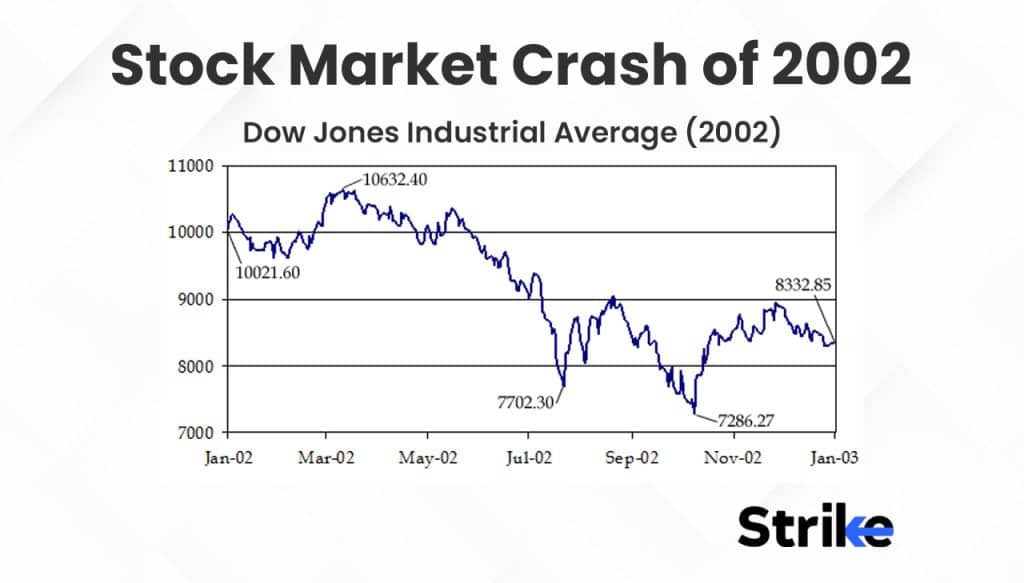
The Dot-com bubble had left the technology sector overvalued, and many companies were unable to generate profits or revenue. Investors became cautious and began to sell their technology stocks. This, combined with the oversupply of infrastructure in the telecommunications industry, led to the market crash of 2002.
The crash had several significant impacts, including financial losses and an economic slowdown. The NASDAQ Composite Index fell from a peak of over 5,000 points in March 2000 to around 1,114 points in October 2002, representing a loss of nearly 78%. Many technology companies saw their stock prices plummet, and several went bankrupt. The crash contributed to the economic slowdown in the United States and globally, with job losses and reduced consumer spending.
The corporate scandals involving Enron, WorldCom, and Global Crossing further eroded investor confidence in the stock market, particularly in the technology sector. The events of September 11, 2001, also worsened the global economic situation.
The market crash of 2002 led to several regulatory changes, with increased scrutiny and regulation of financial markets. The enactment of the Sarbanes-Oxley Act in 2002 aimed to improve corporate governance and financial transparency.
The crash reinforced the importance of conducting thorough due diligence, avoiding overvaluation and market speculation, and promoting strong corporate governance and financial transparency.
5. Financial crisis of 2008
The Financial Crisis of 2008, also known as the Global Financial Crisis or the Great Recession, was a severe economic downturn that began in 2007 and lasted until 2009. It had widespread effects on the global economy and led to numerous government interventions and regulatory changes.
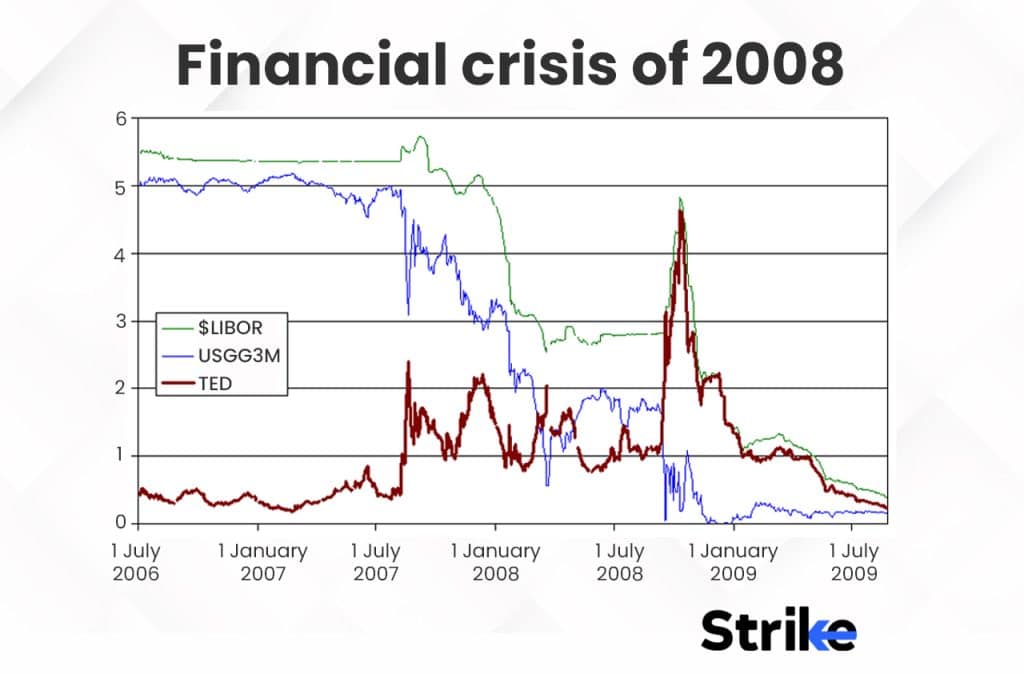
One of the primary causes of the crisis was the housing bubble, fueled by low-interest rates, easy credit, and speculative investments in the real estate market. This led to a rapid increase in housing prices and a surge in subprime mortgage lending. Financial institutions started offering subprime mortgages to borrowers with low credit scores, which carried higher risks. These mortgages were then packaged into mortgage-backed securities (MBS) and collateralized debt obligations (CDO) and sold to investors.
Another contributing factor was the deregulation of the financial sector, which allowed banks to engage in riskier activities, such as investing in complex financial products and increasing leverage. Financial institutions created complex financial products, such as CDOs and credit default swaps (CDS), which were difficult to value and assess their risks accurately. Credit rating agencies assigned high ratings to risky financial products, leading investors to underestimate the risks associated with their investments.
The peak and collapse of the crisis were marked by the bursting of the housing bubble in 2007, causing a sharp decline in housing prices and a surge in foreclosures. The collapse of the housing market led to an increase in mortgage delinquencies and defaults, causing the value of MBS and CDOs to plummet. Several large financial institutions faced significant losses due to their exposure to toxic assets, leading to a series of high-profile bankruptcies and government bailouts.
The impact of the crisis was severe, with high unemployment, reduced consumer spending, and a decline in global trade leading to a severe economic recession. Stock markets around the world experienced massive losses, eroding trillions of dollars in wealth. The financial crisis led to a credit crunch, making it difficult for consumers and businesses to obtain credit.
Governments around the world responded to the crisis with measures, such as bailouts, stimulus packages, and monetary policy actions (e.g., lowering interest rates and quantitative easing). The crisis led to a push for regulatory reforms in the financial sector, including the Dodd-Frank Wall Street Reform and Consumer Protection Act in the United States and the establishment of the European Banking Union in Europe.
The crisis highlighted the importance of robust financial regulation, transparency, and better risk management practices in the financial sector. The crisis serves as a reminder of the risks associated with financial instability and the need for effective regulation and oversight.
6. Coronavirus crash of 2020
The Coronavirus Crash of 2020 was a global financial crisis that had far-reaching consequences. The rapid spread of COVID-19 led to widespread economic disruptions and uncertainties, causing a significant decline in stock markets worldwide. The pandemic’s impact was compounded by supply chain disruptions, as businesses and factories shut down to prevent further infections. There was also a sudden drop in demand for many goods and services, particularly in the travel, hospitality, and entertainment sectors, as people stayed indoors.
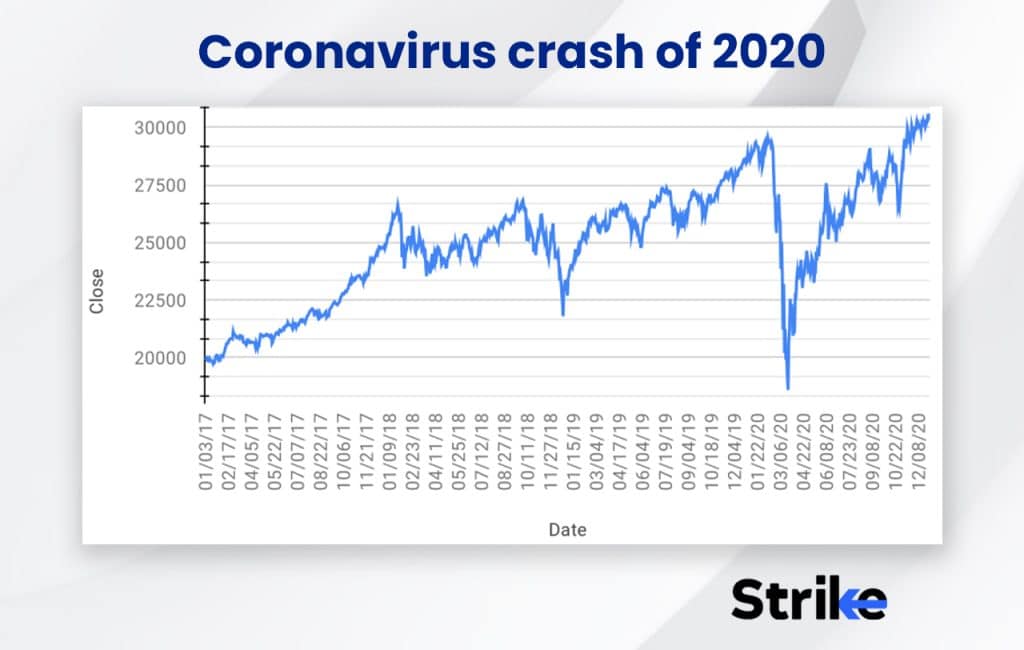
A price war between Russia and Saudi Arabia led to a collapse in oil prices at the same time, further exacerbating market volatility. The crisis led to significant declines in stock markets worldwide, with some indices experiencing their biggest one-day drops in history. The combined effect of demand and supply shocks pushed many countries into a recession, with widespread job losses as businesses closed or downsized due to the economic downturn.
Governments around the world implemented fiscal and monetary measures, such as stimulus packages, interest rate cuts, and quantitative easing, to support their economies. As countries began to control the spread of the virus and lift restrictions, economies started to recover, albeit at different paces.
The pandemic accelerated the adoption of digital technologies, as businesses and individuals adapted to remote work and online services. The crisis also led to a surge in e-commerce, as consumers turned to online shopping to minimize physical contact.
The pandemic has reshaped many industries, with some sectors experiencing growth, while others have faced significant challenges. For example, e-commerce, streaming services, and pharmaceuticals experienced growth, while travel, hospitality, and brick-and-mortar retail faced significant challenges.
How long does the Stock Market Crash last?
The length of a stock market crash varies depending on the cause and severity of the crisis. Accrash may last only a few days or weeks before markets start to recover in some cases, while in other cases, it may take months or even years for markets to recover fully.
The stock market crash of 1987, also known as Black Monday, saw the Dow Jones Industrial Average drop over 22% in a single day. But the markets recovered relatively quickly, with the Dow Jones returning to its pre-crash levels within two years.
But the Great Depression of the 1930s saw the stock market crash and enter into a prolonged period of decline, with the Dow Jones losing almost 90% of its value over a four-year period. It took over 25 years for the markets to recover and reach their pre-crash levels.
The length of a stock market crash also depends on the actions taken by governments and central banks. Stimulus measures, such as fiscal stimulus packages and monetary policy actions, help to support the economy and reduce the severity of a crash.
Will you be able to predict future Stock Market Crashes?
Yes, analysts and experts use various models and indicators to identify potential warning signs of an impending crash. Some warning signs to look out for include high levels of market volatility, a sudden drop in stock prices, high amounts of margin debt, and a shift in investor sentiment.
What are the advantages and disadvantages of a Stock Market Crash?
A crash in the stock market is generally regarded as a negative event, but it is possible for there to be positive aspects to such an occurrence. The following is a rundown of the potential benefits and drawbacks.
Advantages: There are four potential benefits to a stock market crash. They are as given below.
Buy opportunity
Investors frequently have the chance to purchase stocks at more affordable prices when the market suffers a decline. This could result in profits in the long run If the market recovers and the value of the stocks continues to rise.
Correction
Crashing markets can sometimes serve as the necessary correction of the market, bringing overvalued stocks back down to more reasonable levels. This may result in a more robust market environment over the course of time.
Financial discipline
Investors benefit from being reminded by a crash of the risks that come with investing in the stock market, which help them maintain their financial discipline. It is possible that this will encourage investing strategies that are more prudent, which will lead to improved decision-making and risk management.
Stimulus measures:
Governments and central banks take measures to stimulate economic activity in an effort to revive stagnant growth. This might result in more people getting jobs and more money being spent by consumers.
These benefits give the traders and investors valuable lessons to defend their funds against a stock market crash in the future.
Disadvantages: There are three main disadvantages to a stock market crash. They are as given below.
Loss of wealth
The potential for investors to suffer a loss of wealth is one of the most significant drawbacks associated with a crash in the market. This may have an effect on your savings for retirement, funds for college, and other long-term financial goals.
Panic and fear
Investors may experience a sense of panic and fear during crashes, which leads to additional selling pressure and exacerbates the downturn. Consumers lose faith in the economy after a downturn, which results in reduced levels of spending and investment. These factors may further contribute to economic stagnation.
Negative impact on businesses
A market crash makes it more difficult for businesses to raise capital, which can result in slowed growth, reduced employment, or even bankruptcy for some companies. This can have a negative impact on businesses.
The potential drawbacks of stock market crashes almost always outweigh the potential upsides. A crash has a negative overall effect on the economy as a whole, as well as on individual investors, businesses, and other organizations.
What will happen when the Stock Market Crashes?
The most immediate impact of a stock market crash is a significant loss of wealth for investors, which affects long-term financial goals. Panic and fear set in, leading to additional selling pressure and worsening the downturn. Businesses struggle to raise capital, leading to reduced employment or even bankruptcy.
Crashes also serve as necessary corrections, bringing overvalued stocks down to more reasonable levels and encouraging improved decision-making and risk management. Governments and central banks may take measures to stimulate economic activity and revive growth.
When the Stock Market Crashes, what do investors do?
Investors will be tempted to panic and sell their holdings when the stock market crqashes. But this is not the best course of action. It is important to remember that crashes are usually temporary and markets tend to recover over time.
Selling during a crash results in significant losses and may cause investors to miss out on potential gains. Investors should consider holding onto their investments or even buying more stocks while they are undervalued. It is also important to maintain a long-term investment strategy and not let short-term market fluctuations dictate investment decisions.
What can people do during a Stock Market Crash?
People have options available to them during a crash in the stock market to protect their investments and possibly profit from the situation. These include the following.
Maintain your composure and steer clear of any frantic selling. Selling in a panic can result in significant losses. It is critical to maintain a rational mindset and base decisions on long-term investment objectives whenever possible.
Examine and reevaluate the holdings in your investment portfolio. Conduct a reassessment of your holdings and check to see if they are in line with your acceptable level of risk and your long-term investment goals. This may require you to rebalance your portfolio or make adjustments to the asset allocation you have chosen.
Diversify your holdings. Having a portfolio that is adequately diversified can help reduce the negative effects of a falling stock market. You might want to think about investing in a variety of asset classes, industries, and geographical locations.
Put your attention on quality stocks and look for investments in fundamentally sound companies that have a track record of consistent earnings, low debt, and robust cash flow. These kinds of businesses have a better chance of weathering turbulent market conditions and getting back on their feet more quickly.
Keep an eye out for buying opportunities. A drop in the value of the stock market could present an opportunity to purchase high-quality stocks at lower prices. Have patience and wait for valuations that are more attractive.
Maintain cash reserves. Having cash on hand enables you to take advantage of investment opportunities that may arise during a crash and helps you avoid selling investments at a loss in order to cover expenses. In addition, having cash on hand enables you to take advantage of investment opportunities that may arise during normal market conditions.
Remember that crashes in the stock market are typically only temporary setbacks in the context of a long-term investment strategy, and keep this in mind as you think about the future. Maintain your focus on your long-term objectives, and steer clear of making rash choices because of short-term shifts in market conditions.
Should I pull my money out during a Stock Market Crash?
No, it is not recommended to pull your money out during a stock market crash. This strategy can result in significant losses and prevent investors from gaining potential profits when the market recovers. It is important to maintain a long-term investment strategy and base decisions on investment objectives rather than short-term market fluctuations. Investors should instead stay calm, reevaluate their investment portfolio, diversify their holdings, focus on quality stocks, keep cash reserves, and look for buying opportunities.
Is it wise to invest in the Stock Market when it Crashes?
No, Investing in the stock market during a crash is a risky move, but it presents opportunities for long-term gains. Crashes are typically temporary setbacks, and markets tend to recover over time. Investors should exercise caution and carefully consider the risks before investing in the stock market during a crash.
Do Stock Market Crashes always recover?
Yes, historically, the stock market has always recovered from crashes. Markets have tended to bounce back over the long term. Investors should keep this in mind and maintain a long-term investment strategy rather than making decisions based on short-term market fluctuations.
Are we currently recovering from the 2020 Coronavirus Crash?
Yes, there has been a recovery from the 2020 Coronavirus Crash. The markets have shown signs of recovery since then while the pandemic caused a steep drop in stock market values.









 Previous Article
Previous Article






No Comments Yet